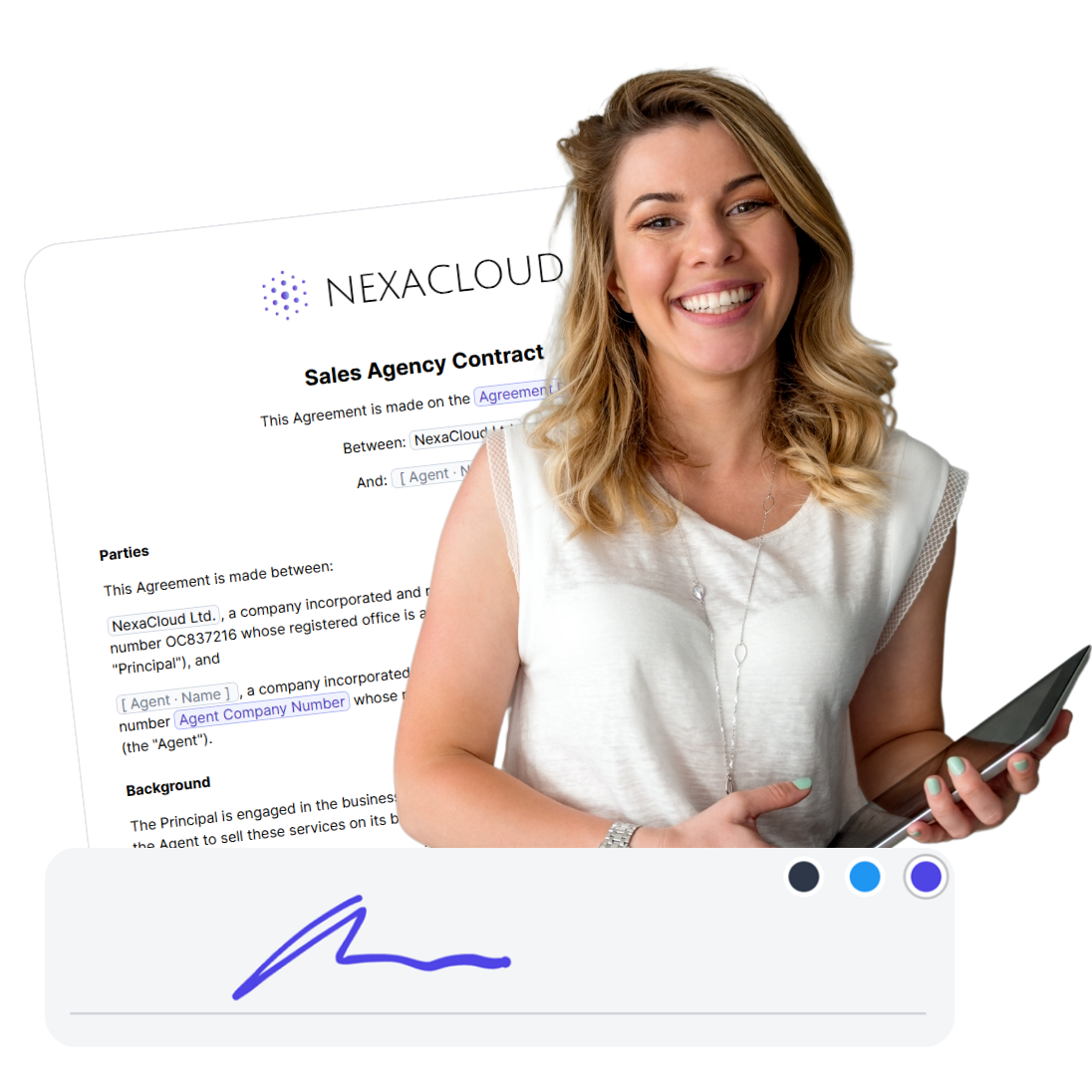What is contract metadata and how it works
Contract metadata is the structured information that describes a contract, like dates, parties, values, obligations, risks and status. It helps teams instantly understand, organize and manage agreements without opening every PDF. In this guide, we explain what is contract metadata exactly and how it works.
- What is contract metadata in simple words?
- What is the purpose of metadata?
- Examples of contract metadata in everyday life
- Why do I need contract metadata?
- What types of contract metadata exist?
- Is metadata personal data?
- How does contract metadata work in action?
- Who is responsible for managing metadata?
- How do I manage contract metadata?
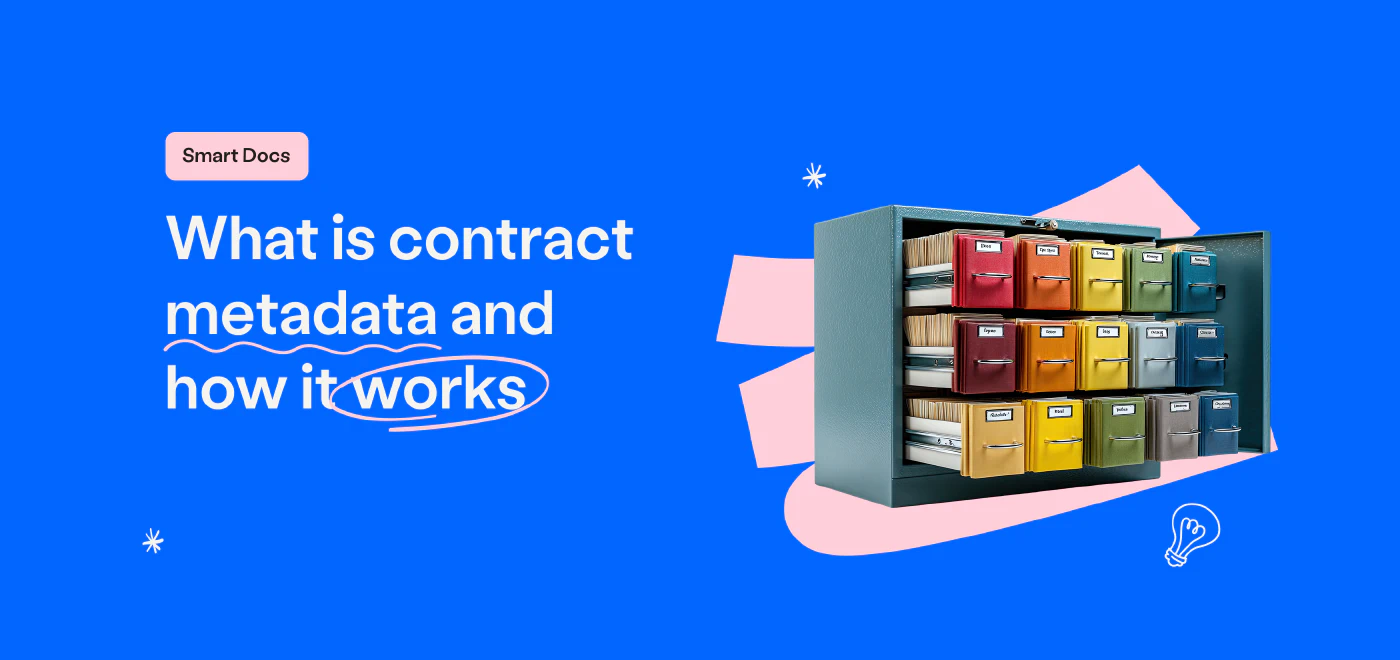
TL;DR
- Contract metadata is the “data about data”, the structured information about a contract (dates, parties, value, obligations), not the text itself.
- It helps you organize, search, track, and manage contracts without opening every PDF.
- Metadata prevents financial loss (missed renewals, wrong payment terms), improves compliance, enables faster search, and supports better business decisions.
- Common contract metadata includes dates, parties, value, obligations, risk indicators, legal terms, status, and internal owners.
- Metadata is extracted, stored, and used to power search, automation, alerts, audits, and reporting.
- Managing it manually is slow and error-prone, using a CLM like fynk gives you automatic extraction, centralized fields, real-time updates, strong search, and workflow automation.
What is contract metadata in simple words?
Contract metadata is the key information about a contract, not the contract text itself, but the details that describe and organize it. It’s structured data that helps you organize, search, track, and manage contracts within a contract lifecycle management (CLM) system or database.
In simple words, metadata lets you understand and organize contracts without having to open and read the entire document every time.
Here’s a simple example:
📚 Contract is like a book in a library
The contract is the book itself — all the pages, the story, the details.
The contract metadata is the information on the library card or in the catalog entry.
The library catalog entry (metadata) includes:
Title → Contract name
Author → Parties involved
Publication date → Effective date
Genre → Contract type (NDA, lease, etc.)
Shelf location → Contract ID / where it’s stored
Due date → Expiration or renewal date
You don’t need to read the whole book to know where it is, what it’s about, and when it’s due back, the catalog tells you.
So, metadata in contracts is NOT
- The full contract text.
- Every sentence or obligation inside the contract.
- Notes or comments.
- Version history or redlines.
- Operational documents attached to the contract.
What is the purpose of metadata?
Metadata’s purpose is to make information easier to understand, find, organize, and use.
That’s why it’s often described as “data about data.”
The main purposes of metadata is to:
- Identify information: helping you know what something is.
- Organize information: grouping or categorizing related items.
- Enable search and discovery: making it easy to find what you’re looking for.
- Support management and tracking: including version control, history, and lifecycle stages.
- Provide understanding and context: explaining how the data should be interpreted or used.
Examples of contract metadata in everyday life
These are the common data points you’ll find in almost any contract, whether it’s a rental agreement, employment contract, NDA, or service agreement.
- Effective date: The date the contract officially begins.
- Termination or renewal dates: Key dates that define when the agreement ends, auto-renews, or requires notice.
- Parties involved: The individuals or companies entering into the contract.
- Contract value or pricing terms: The financial amounts, fees, or payment schedules defined in the agreement.
- Governing law or jurisdiction: The legal framework that determines how the contract is interpreted.
- Signatories: The people who sign the contract, including their roles.
- Obligations and deliverables: What each party must do under the agreement.
- Contract duration: How long the agreement is valid, whether fixed-term or indefinite.
Why do I need contract metadata?
You need contract metadata because it transforms your contracts from static, passive documents into dynamic, strategic business assets.
Here are the four key reasons why you need contract metadata:
1. Prevent financial loss & missed opportunities
This is the most critical reason for most businesses.
- Avoid Auto-Renewals: By tracking the Expiration Date and the Notice Period.
- Track Revenue: The Contract Value and Payment Terms metadata allow the Finance team to accurately forecast revenue or liabilities, giving a real-time picture of the company’s financial health.
- Enforce SLAs: Metadata can track Service Level Agreements (SLAs) or specific obligations, ensuring you collect penalties when a vendor underperforms or fulfill your own deliverables on time.
2. Make contracts findable
No one wants to spend hours reading through PDFs to find one specific clause. Metadata makes your contracts instantly accessible.
- Quick Retrieval: Instead of searching for keywords that may or may not be in the document, you can search structured fields like:
- “Show me all Master Service Agreements (MSA) with Vendor X.”
- “Show me all contracts in the Europe jurisdiction.”
- Centralized Knowledge: It moves critical data out of individual hard drives, email inboxes, or filing cabinets into a central, searchable hub that everyone can access and trust.
3. Manage risk and ensure compliance
Metadata provides the data required for legal and regulatory compliance.
- Compliance Monitoring: You can tag contracts with Regulatory Clauses (like GDPR or HIPAA requirements) and quickly pull reports to prove to an auditor that the proper agreements are in place.
- Risk Identification: You can sort contracts by a Liability Cap or Indemnification Clause metadata field to quickly see which agreements expose the company to the highest risk.
4. Enable strategic decision-making
Metadata allows you to analyze your entire contract portfolio, not just one contract at a time.
- Portfolio Analysis: You can generate reports that answer strategic questions like:
- “What is our total annual spend across all vendors in the IT Services category?”
- “Which of our contract templates have the longest average negotiation time?”
- Informed Negotiation: Before starting a new negotiation, you can quickly analyze past contract metadata to see what terms you successfully included (or excluded) with a specific counterparty, giving your team a data-backed advantage.
What types of contract metadata exist?
Contract metadata falls into several categories that help describe, organize, and manage an agreement. The most common types include:
1. Administrative metadata
Administrative metadata contains foundational information that identifies the contract.
- Contract name
- Document type
- Version number
2. Party metadata
Party metadata describes the entities and people involved in the agreement.
- Legal entity name
- Contact email
- Authorized signatory
3. Date metadata
Date metadata captures important timelines throughout the contract lifecycle.
- Start date
- Signature date
- Renewal deadline
4. Financial metadata
Financial metadata reflects the financial structure and commitments in the agreement.
- Total contract value
- Payment frequency
- Discount rate
5. Obligation metadata
Obligation metadata outlines what each party is required to do under the contract.
- Delivery schedule
- Responsibilities
- Service commitments
6. Legal metadata
Legal metadata defines the legal context and restrictions tied to the agreement.
- Governing law clause
- Jurisdiction
- Liability limitation
7. Performance metadata
Performance metadata tracks whether contractual commitments are being met.
- Required uptime
- Quality targets
- Reporting schedule
7. Lifecycle metadata
Lifecycle metadata indicates the current phase and progression of the contract.
- Contract status
- Approval stage
- Expiration date
8. Risk metadata
Risk metadata highlights factors that could create legal or operational risk.
- Risk rating
- Compliance flags
- Renewal risk indicator
9. Operational metadata
Operational metadata supports internal organization and classification.
- Internal owner
- Department assignment
- Document tags
Depending on how you arrange the agreement, contract metadata can appear in many different formats (especially if you are using a digital contract version). For example:
- Text fields (e.g., contract name, responsibilities)
- Date fields (e.g., effective date, renewal date)
- Number fields (e.g., total value, KPI targets)
- Currency fields (e.g., pricing, monthly fees)
- Percentage fields (e.g., discount rate, SLA uptime)
- Dropdown fields (e.g., governing law, contract status)
- Tags or labels (e.g., department, category)
- Boolean fields (e.g., sensitive data: yes/no)
Is metadata personal data?
Metadata can be personal data if it identifies a person directly or indirectly. For example, names, email addresses, user IDs or signatures included as contract metadata count as personal data. However, metadata that does not relate to an identifiable individual, such as contract value or renewal dates, is not considered personal data.
How does contract metadata work in action?
Here is a step-by-step breakdown of how contract metadata works, focusing on the three main phases:
1. Data extraction
The process begins by exttracting all metadata from the contract document.
- Extraction: A person (manual entry) or, more commonly, an AI-powered system (automated extraction) like fynk reads the contract file (e.g., PDF, Word document).
- Identification: The system identifies specific pieces of information based on pre-defined rules or machine learning models. For instance, it identifies the text in the signature block as the Parties Involved and the date written next to “Effective from” as the Effective Date.
- Structuring: The extracted information is then taken out of the document’s free-flowing text and placed into a structured database field.
| Contract Text Excerpt | Metadata Field | Metadata Value |
|---|---|---|
| “…entered into this Master Service Agreement… by and between Gemini Corp and Acme Inc… for a term commencing on November 1, 2025.” | Contract Type | MSA |
| Counterparty | Acme Inc | |
| Effective Date | 2025-11-01 |
How fynk handles this:
In fynk, AI Analysis automatically extracts key fields the moment you upload a contract. The system highlights detected values, lets you confirm or adjust them, and instantly maps them into the correct metadata fields.
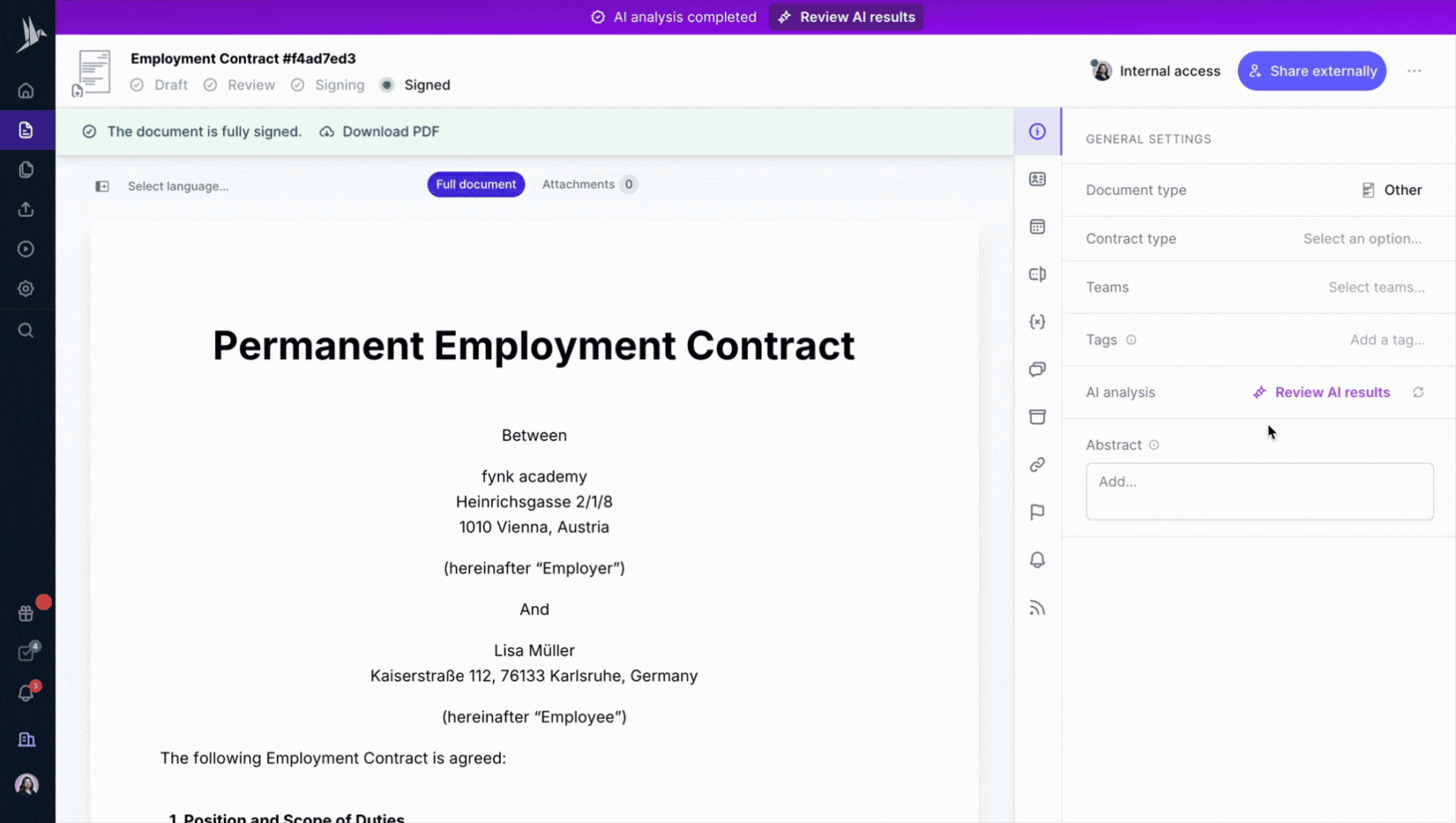


AI analysis in fynk
2. Storage and organization
Once extracted, the metadata is stored in a centralized system, separate from the actual document.
- Central Repository: The contract document itself is usually stored in a secure location (like a cloud drive or a document management system).
- Database Linking: The metadata (the values from the table above) is stored in a database. Crucially, each set of metadata is linked to its unique contract file via a unique identifier. This is how the system knows that the metadata “Expiration Date: 2026-11-01” belongs to Contract File #1234.
- Standardization: The storage enforces standardized formats (e.g., ensuring all dates are in $YYYY-MM-DD$ format and all Contract Types are selected from a pre-approved picklist). This structure is essential for accurate searching.
How fynk handles this:
fynk stores every contract and its metadata inside a unified contract workspace. All fields follow predefined formats, drop-down lists and validation rules, ensuring consistent data across all agreements. Each contract has its own unique ID, so metadata stays linked, organized and fully searchable within the platform.
3. Action and utilization
This is where the metadata delivers value by allowing the system and users to interact with the contract data strategically.
Searching: Instead of searching the legal text, a user queries the metadata database: “Show me all Active contracts where the Counterparty is ‘Acme Inc’ and the Contract Type is ‘MSA’.” The system instantly returns the unique IDs of all matching contracts.
Automation: The system monitors key metadata fields. For example, it checks the Expiration Date (2026-11-01) and the Notice Period (90 days). When the current date hits the 90-day warning threshold, the system automatically triggers an email alert to the Contract Owner.
Reporting: A user can aggregate metadata from thousands of contracts to run a report: “Calculate the Total Contract Value for all contracts expiring in Q4 2026.”
In short, metadata works by separating the facts from the document and putting those facts into a structured, searchable database, allowing software to automate and manage the contracts.
How fynk handles this:
fynk turns metadata into immediate action: you can filter by any field, create dynamic views, trigger automated workflows (like approval routing or renewal reminders) and build real-time dashboards. Every metadata field becomes usable for alerts, reporting and decision-making — making your contract data actionable from day one.
Who is responsible for managing metadata?
The responsibility for managing contract metadata is shared across multiple roles and departments, but ultimately rests with a designated owner who ensures data quality.
It’s not just one person; it’s a collaborative process supported by governance policies.
Here is a breakdown of the key roles involved in managing contract metadata:
1. The contract owner
This is the person with the primary accountability for a specific contract.
Who they are: Usually a manager or director from the business unit that benefits most from the contract (e.g., Procurement for a vendor contract, Sales/Account Management for a customer contract).
Key Responsibility: To validate and maintain the metadata for that contract. They must ensure the critical dates (especially renewal/termination dates) and key terms (value, scope) are entered correctly, kept up-to-date throughout the contract’s life, and act on the automated alerts the system generates.
2. The legal and compliance team
The Legal team owns the consistency and legality of the data.
Key Responsibility:
Defining the Schema: Establishing the official definitions and standardized values for the metadata fields (e.g., ensuring “Governing Law” is always from a pre-approved list).
Overseeing Extraction: Managing the AI or manual process of extracting risk-related metadata, such as Indemnification Clauses, Liability Caps, and Compliance Requirements.
3. The IT/System administration team
This team owns the Contract Lifecycle Management (CLM) platform itself.
Key Responsibility:
System Integrity: Configuring the CLM system to enforce the metadata standards (e.g., setting up picklists, mandatory fields, and date formats).
Integrations: Ensuring the contract metadata flows accurately between the CLM and other business systems like CRM (Salesforce) and ERP (SAP).
Security: Managing access controls so only authorized users can view or edit sensitive metadata.
4. The Finance/Procurement team
These teams are the primary consumers of the financial metadata.
Key Responsibility:
Financial Accuracy: Ensuring the Contract Value, Payment Terms, and Billing Frequency are accurately captured to support budgeting, forecasting, and audit needs.
Reporting: Utilizing the metadata to run strategic reports on spend, revenue, and overall contract portfolio health.
How do I manage contract metadata?
There are two main ways to manage contract metadata: manually or digitally using a contract lifecycle management tool.
- Manual management: Tracking details in spreadsheets or shared folders and updating them by hand. It works for small teams but quickly becomes error-prone as information scatters, versions drift and consistency relies on individual effort.
- Digital management (using a CLM): A system like fynk centralizes metadata, extracts key fields automatically and keeps everything up to date. This cuts manual work, improves accuracy and gives teams real-time visibility into obligations, risks and renewals, making it the more scalable, reliable option.
"Our biggest gain is having one central hub for all contracts. No more folders or email chains. Everything is secure and transparent"

Legal Solutions Manager at Unite
For effective management you need to use a contract management system, because it provides a structured way to capture, organize, track, and update all the key data points that live around your contracts.
Here’s how you can manage your contract metadata in a CLM like fynk:
Centralized metadata fields: Every contract in fynk comes with structured fields (like parties, dates, values, status, obligations) that are stored in one place and stay consistent across the entire workflow.
Automatic extraction and updates: fynk can read documents using it’s powerful AI Analysis feature and automatically pull out key information, reducing manual work and ensuring fields stay accurate as the contract moves through draft, review and approval.
Editable and fully searchable: Users can update any metadata field directly in the contract record, and all metadata becomes searchable and filterable, making it easy to find contracts based on dates, terms, values or custom fields.



System metadata in fynk settings
- Integrated with workflows and reporting: Metadata powers reminders, approval routing, dashboards and renewal alerts, so the data you maintain directly drives automation and visibility throughout your contract process.
Want to see how metadata works in your own contracts?
👉 Upload your first contract safely and try our AI Analysis to extract all metadata.
or
👉 Schedule a demo to see it in action.
Searching for a contract management solution?
Find out how fynk can help you close deals faster and simplify your eSigning process – request a demo to see it in action.
Please keep in mind that none of the content on our blog should be considered legal advice. We understand the complexities and nuances of legal matters, and as much as we strive to ensure our information is accurate and useful, it cannot replace the personalized advice of a qualified legal professional.

Table of contents
- What is contract metadata in simple words?
- What is the purpose of metadata?
- Examples of contract metadata in everyday life
- Why do I need contract metadata?
- What types of contract metadata exist?
- Is metadata personal data?
- How does contract metadata work in action?
- Who is responsible for managing metadata?
- How do I manage contract metadata?
Want product news and updates? Sign up for our newsletter.
Other posts in Smart Docs

What you can track using fynk’s audit trail
When you work with contracts, knowing exactly what happened to a document and when is essential. fynk …

What is contract metadata and how it works
Contract metadata is the structured information that describes a contract, like dates, parties, values, …
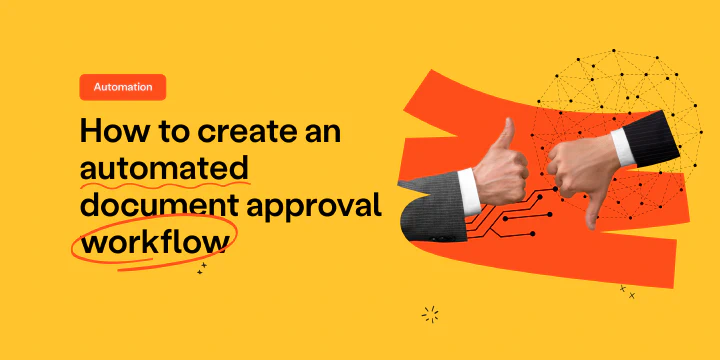
How to create an automated document approval workflow?
An automated document approval workflow helps your team move faster, stay organized, and avoid the delays and …
Other posts in Contracts

What is contract metadata and how it works
Contract metadata is the structured information that describes a contract, like dates, parties, values, …
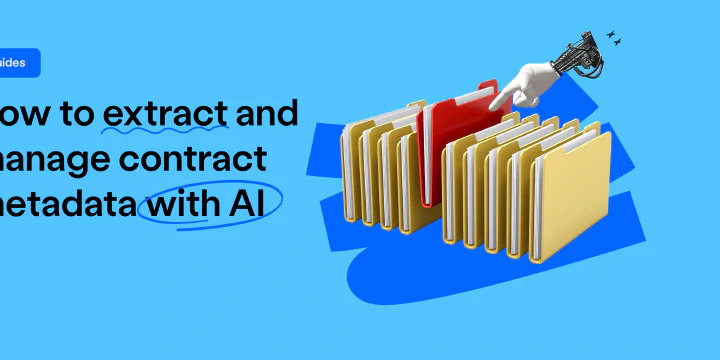
How to extract and manage contract metadata with AI
Contracts contain critical information, but finding it shouldn’t take hours. Instead of manually searching …

How to create an automated document approval workflow?
An automated document approval workflow helps your team move faster, stay organized, and avoid the delays and …
Contracts can be enjoyable. Get started with fynk today.
Companies using fynk's contract management software get work done faster than ever before. Ready to give valuable time back to your team?
Schedule demo

